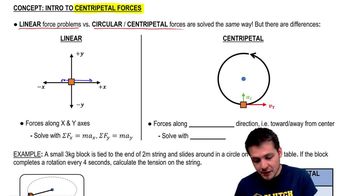Here are the essential concepts you must grasp in order to answer the question correctly.
Gravitational Force
The gravitational force is the attractive force between two masses, described by Newton's law of universal gravitation. It is directly proportional to the product of the masses and inversely proportional to the square of the distance between their centers. This force is crucial for understanding the motion of satellites in orbit, as it provides the necessary centripetal force to keep them in circular paths.
Recommended video:
Gravitational Forces in 2D
Centripetal Force
Centripetal force is the net force required to keep an object moving in a circular path, directed towards the center of the circle. For satellites in orbit, this force is provided by gravity. The relationship between the gravitational force and centripetal force allows us to calculate the forces acting on different satellites based on their masses and orbital radii.
Recommended video:
Intro to Centripetal Forces
Orbital Period
The orbital period is the time taken for a satellite to complete one full orbit around a planet. It is influenced by the satellite's distance from the planet and its mass. The relationship between the orbital period and the radius of the orbit can be described by Kepler's laws, which help in determining the forces acting on satellites with different masses and distances from the planet.
Recommended video:




